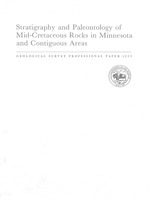PART A: Molluscan fossils are locally abundant at outcrops of Upper Cretaceous rocks in eastern North and South Dakota, northeastern Nebraska, northwestern Iowa, and western and northern Minnesota. Other Cretaceous mollusks have been found in the glacial deposits in Minnesota, Iowa, and Illinois.
The oldest well dated marine mollusks are of earliest late Cenomanian age and occur in northwestern Iowa. Mollusks of marginal marine
and nonmarine environments in northwestern Iowa and south-central Minnesota are probably of slightly younger late Cenomanian age. The youngest mollusks treated in this report are bivalves of Santonian age found in the Niobrara Formation in eastern North and South Dakota.
The collections indicate the presence or former presence of the following ammonite zones in the northeastern part of the Western Interior seaway:
Santonian: Scaphites depressus-Clioscaphites choteauensis
Coniacian: Scaphites uentrocosus; Scaphites preuentricosus
Turonian: Scaphites coruensis; Scaphites whitfieldi; Prionocyclus hyatti; Subprionocyclus percarinatus; Collignoniceras woollgari; Watinoceras coloradoense
Cenomanian: Dunueganoceras albertense; Dunueganoceras pondi
PART B: Sedimentary rocks of early Late Cretaceous age occur in the eastern parts of North Dakota, South Dakota, and Nebraska, and in Minnesota and western Iowa. They are generally included in, from oldest to youngest, the Dakota Formation, Graneros Shale, Greenhorn Formation, Carlile Shale, and Niobrara Formation. However, in eastern North Dakota, they are also assigned to, in ascending order, the Belle Fourche Shale, Greenhorn Formation, Carlile Shale, and Niobrara Formation. The Graneros Shale and laterally equivalent strata in the Belle Fourche Shale grade eastward into the Coleraine Formation of northeastern Minnesota and probably into the Windrow Formation of southeastern Minnesota. Cretaceous beds locally overlie rocks of Precambrian, Paleozoic, and Jurassic ages, and they are generally overlain by glacial drift and alluvium of Quaternary age. In Minnesota and adjoining areas, formations of mid-Cretaceous age commonly overlap the dissected surface of Precambrian rocks. The thickness of the lower Upper Cretaceous sequence ranges from about 223 m in eastern North Dakota and about 200 m in northeastern Nebraska to a featheredge in Minnesota and Iowa.
These lower Upper Cretaceous formations are composed mainly of shale, siltstone, sandstone, and limestone units of marine and nonmarine origin and were deposited near the eastern shore of a transgressing and regressing epicontinental sea in Cenomanian Turonian Coniacian. and Santonian time. During the late Cenoanian, the strandline was in Minnesota and was oriented generally northnortheast. Interpretations of the depositional environments of the strata and of fossils from outcrops and from clasts in glacial drift indicate that the Cretaceous seaway extended from this region northeastward across Canada to Greenland in the Turonian Coniacian, and Santonian.
The Cretaceous formations are deformed into broad, shallow synclines in eastern North and South Dakota and in northeastern Nebraska. A west-trending anticline, the Sioux uplift, separates the synclines in southeastern South Dakota. Sparse evidence of minor faulting in the formations exists in northeastern South Dakota, along the strike of a major southwest-trending zone of tectonism in the Precambrian basement rocks. The structural relief in the region, on the top of the Greenhorn Formation, is at least 250 m between eastern North Dakota and northeastern Minnesota, and at least 200 m between northeastern Nebraska and northwestern Iowa.
A comparison of the Cretaceous stratigraphy of the Minnesota region and of areas in Wyoming indicates that some marine transgressions and regressions were synchronous in the two regions. The transgression during Greenhorn time, the regression during early Carlile time, and the transgression dur


